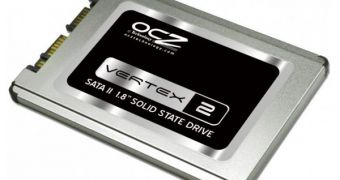Solid state drives are all built according to the same basic principle, but there are two specific form factors that ultimately determine what sort of application such storage units are used for. The 3.5-inch form is the one commonly used in desktops, whereas 2.5-inch units are employed mostly by laptops. When it comes to ultrathin mobile PCs, however, the 2.5-inch drives practically dictate the minimum thickness of the machine. This makes the storage unit one of the main factors behind how slim, portable computers haven't exactly turned much thinner lately.
OCZ seeks to remedy this with the aid of the Vertex 2 and Onyx SSDs, which employ the 1.8-inch form factor. They will also, most likely, show up in future netbooks and even tablet PCs. The Vertex 2 are, predictably, the higher-end models.
They operate on the SATA 3.0Gbps interface and are constructed out of MLC (Multi-level cell) NAND Flash memory chips. Capacities range from 60GB all the way up to 240GB, whereas the SandForce SF-1200 controller enables read and write speeds of 285MB/s and 275MB/s, respectively, as well as a 4kB random write performance of 50,000 IOPS. Furthermore, support for the TRIM command ensures that overall performance does not decrease over time.
The Onyx SSDs are built with affordability in mind. To this end, they feature capacities of 32GB and 64GB, MLC NAND Flash memory and, though using the same SATA 3.0Gbps interface as the Vertex 2, only manage to read and write at 145MB/s and 120MB/s, respectively (135/70 MB/s for the 32GB device).
The cause for this is that, instead of the highly competent but pricey SandForce, the Indilinx Amigos controller is present. Though the company chose to disclose that the Onyx and Vertex 2 would have warranties of three and two years, prices were not mentioned.

 14 DAY TRIAL //
14 DAY TRIAL //